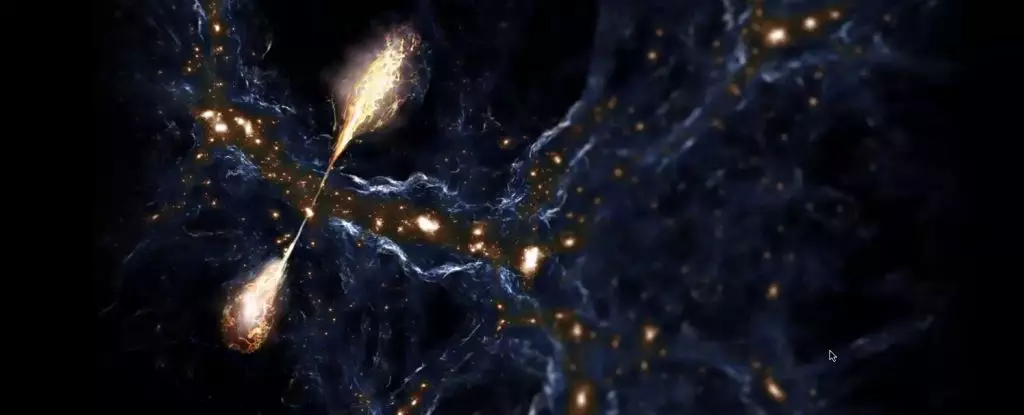Astronomers have recently made a groundbreaking discovery in the realm of astrophysics with the identification of Porphyrion, a supermassive black hole creating the largest known structure of galactic origin. This colossal formation stretches an impressive 7 megaparsecs across—approximately 23 million light-years—making it a vital component of the cosmic web that binds galaxies and clusters throughout the universe. Named after the Greek king of giants, Porphyrion symbolizes the intimate connections existing between the vast and the minuscule in cosmic realms.
Leading astronomer Martijn Oei from Leiden University and Caltech has shed light on the sheer scale of Porphyrion’s jets, stating, “If we shrink the jets to the size of the Earth… the black hole would have the size of 0.2 millimeters: the size of an amoeba or a mite on your skin.” This analogy underscores the astounding ability of a seemingly tiny cosmic entity to effectuate such monumental phenomena, akin to an amoeba producing an Earth-sized fountain of energy.
The revelation of Porphyrion’s expansive jets isn’t merely an isolated case; it follows closely on the heels of the discovery of Alcyoneus, another immense galaxy with jets extending 16 million light-years. These findings suggest that the mechanisms facilitating these gigantic jets—once thought to be anomalies in cosmic behavior—may, in fact, be more commonplace in the universe than previously assumed. This insight begs further investigation into the conditions necessary for these ‘impossible’ jets to exist and thrive.
The formation of astrophysical jets generated by black holes remains only partially understood. It is known that as a black hole consumes surrounding material, some of that matter gets redirected, accelerated, and expelled along magnetic field lines, forming jets that travel at remarkable fractions of the speed of light. While that mechanism is understood to some extent, the gigantic size of jets from objects like Alcyoneus and Porphyrion presents challenges that confound our mathematical models and theoretical constructs.
One pressing question revolves around the stability and longevity of these immense jets. For a supermassive black hole to create such extensive jets, it must maintain a continuous feeding process over an extended period—up to a billion years. This requeriment indicates a substantial reservoir of material, which isn’t a common attribute observed in black hole behavior. Additionally, as jets extend further out into space, they encounter increasing instability, leading many theorists to predict that disruptions will eventually render them ineffective.
Oei emphasizes this point: “Both pen-and-paper work and numerical simulations of jet physics suggest that jets are unstable structures.” Instabilities could lead to a variety of outcomes that would hamstring the jets’ growth and durability. Unraveling how Porphyrion’s jets circumvent such challenges—remaining intact over unfathomable distances—is crucial for deepening our understanding of cosmic structures.
The cosmic web—a vast, intricate system formed from filaments of dark matter—acts as the foundation for galaxies and their clusters. Porphyrion’s jets, according to researchers, extend approximately 66% of the radius of the void containing it, hinting at the possibility that these immense jets are influential in shaping the cosmic web’s architecture. This influences not only density but may also account for unexpectedly high temperatures detected in otherwise vacant voids—all potential consequences of jet activity.
Few black holes of this type are still active in the early universe; Porphyrion exemplifies a radiatively active black hole that emits substantial radiation. This observation raises the tantalizing possibility that far more of these gigantic cosmic jets were present in the early universe than we currently recognize.
Future Discoveries Await
As instruments and observational technologies improve, Oei anticipates that the cosmic landscape will yield a greater number of galaxies known to possess jet-producing black holes. “I think galaxies with giant jets are more common than we realize,” he remarks. His optimism signals a future brimming with exploration and discovery, with the potential to redefine our comprehension of cosmic evolution and structure.
The ongoing investigation into the properties of black holes like Porphyrion has significant implications, not only for astrophysics but for our broader understanding of the universe itself. As new galaxies and their extraordinary jets are uncovered, humanity’s grasp of cosmic intricacy will likely evolve, driven by an insatiable curiosity for what lies beyond.


Leave a Reply